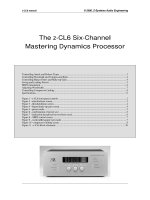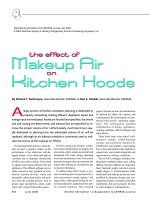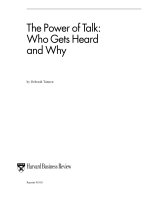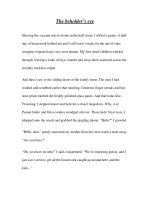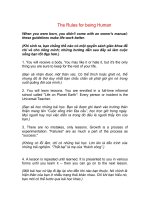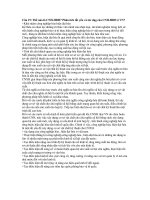Tài liệu The Market for Sculptures: an Adjacent Year Regression Index pptx
Bạn đang xem bản rút gọn của tài liệu. Xem và tải ngay bản đầy đủ của tài liệu tại đây (173.93 KB, 22 trang )
The Market for Sculptures:
an Adjacent Year Regression Index
Marilena Locatelli-Biey
Department of Economics
University of Torino - Italy
E-mail:
Roberto Zanola
Department of Public Policy and Public Choice - Polis
Corso Borsalino, 50 – 15100 Alessandria - Italy
E-mail:
ABSTRACT: This paper analyses the performance of an investment in sculptures during the period 1987-1995 by applying
the hedonic price technique with time dummy variables to a sample of over 27,000 sales occured at auctions. The main
finding is that the trend of the rate of return on an investment in sculptures is more stable than those associated to alternative
forms of investment during the analysed period.
JEL Classification Numbers: C5, Z1.
Key Words: Auction; Hedonic Price; Sculpture; Return.
1 Introduction
Sculpture is the art of producing in three dimensions representations of natural
or imagined forms and it embraces a variety of construction-techniques as well
as a variety of materials
1
. The most important classi…cation of sculpture is
based on the raw material used, but it is also important the size, the function,
and the period of the production.
The market for sculptures has characteristics that make it di¤erent from
other markets for collectibles. Although similar to the market for paintings,
the market for sculptures is smaller than it, with about 3-5 per-cent of total
collectibles sold at auctions. A number of reasons explain this, such as technical
di¢culties and the high costs of production as well as the fact that sculptures
need appropriatespaces to be placed or because of the lower number of sculpture
collectors than painting collectors [Locatelli-Biey and Zanola, 1999a].
The purpose of this paper is to examine the investment value of sculptures.
Although there are a number of studies that have investigated the investment
valueof collectibles, such aspaintings [Anderson, 1974; Stein, 1977; Buelens and
Ginsburgh, 1993; de la Barre et al., 1994; Chanel, 1995; Chanel et al., 1996;
Mossetto and Lazzaro, 1996; Agnello and Pierce, 1996; Candela and Scorcu,
1997; Renneboog and Van Houtte, 1998; Agnello and Pierce, 1998; Locatelli-
Biey and Zanola, 1999b], prints [Pesando, 1993], violins [Ross and Zondervan,
1989], wine [Nerlove, 1995; Combis et al., 1997], antique furniture [Graeser,
1
The raw material depends on the construction technique. Hand modelling uses terracotta,
or raw material that allows to produce glazed ceramics. Casting is an ancient technique which
uses bronze. Carving is performed by using a number of di¤erent materials, such as marble,
stone, wood, ivory, bone, and, more recently, plaster and resin.
1
1993], photos [Pompe, 1996], to our knowledge this it is the …rst time that the
performance of sculptures as …nancial assets is studied.
This study applies the hedonic price technique
2
with time dummy variables
which allows price indexes for sculptures and shadow values for characteristics
to be simultaneously estimated. Data are drawn from auctions hold during
the period 1987-1995, as compiled by Mayer International Auction Record on
CD-Rom.
The remainder of this paper is organised as follows. Section 2 brie‡y outlines
the methodology of the hedonic technique. Section 3 de…nes the empirical
speci…cation of the model. Section 4 describes the data set used, which is
compiled from Mayer International Auction Records on CD-Rom. Section 5
summarises the basic …ndings. Conclusions are drawn in Section 6.
2
See Gordon (1990); Griliches (1990); and Triplett (1990).
2
2 Methodology
The approach used to estimate a price index for sculptures is the hedonic price
technique as developed in similar studies analysing the investment value of
collectibles. The hedonic approach involves the estimate of the implicit prices
to each characteristic included in the equation by allowing to control for possible
non-temporal determinants of price variations.
A set of j-characteristics, x
jkt,
with j = 1;:::n; are identi…ed for a regression
of the price of the sculpture k, with k = 1;:::;m, sold in year t, with t = 1;:::;T;
on its j-characteristics, such that:
lnp
kt
= ¯
0
+
T¡1
X
t=1
¯
t
z
t
+
n
X
j=1
°
j
x
jkt
+ "
kt
(1)
where lnp
kt
is the logarithm of the price of sculptures sold in year t; z
t
is a
dummy equal to 1 when a sale occurs in year t, 0 otherwise; ¯
0
;¯
t
and °
j
are
coe¢cients to be estimated, where °
j
is the implicit price; "
kt
is the random
error term, with " s N (0;
P
k
-I
T
).
Two observations are necessary. First, an implicit assumption in (1) is
that the social valuation of sculpture characteristics does not change over time
given the shortness of the analysed period. Secondly, the model is speci…ed
in semi-log transformations in order to handle the severe skewness in auction
prices. Transforming the dependent variable, enables us to use ordinary least
squares estimators without having to worry about the sensitivity of the results
to skewness.
Based on hedonic regression equation (1), a number of price indexes can be
computed
3
. In this study we adopt the adjacent year regressions index, which
implicitly weights each observation equally [Berndt et al., 1995].
3
In this respect, we are only considering sculptures as …nancial assets, without any refer-
3
By subtracting from the logarithm of the auction price the implicit prices
given to speci…c characteristics, the characteristic-free price of sculpture k in
year t is equal to:
z
kt
= lnp
kt
¡
n
X
j=1
°
j
x
jkt
(2)
Given the functional form of equation (1), the annual return on a ‘standardised
sculpture’ [Buelens and Ginsburg, 1993] may be written as:
¯
t
=
1
m
t
X
z
kt
(3)
Setting the price index at time t equal to 1, the price index at time t+1 is
given by exponentiating the coe¢cient associated to the time dummy variable
from adjacent year regressions. De…ne I
t
the price index at time t, the adjacent
year regression index is:
I
t+1
= I
t
(1 + ³) (4)
where » is equal to e
(
b
¯
t+1
¡
b
¯
t
)
¡1:
ence to their psychic returns [Baumol, 1986; Frey and Eichnberger, 1995; Santagata, 1998;
Czujack, 1997].
4
3 Functional Form
The hedonic regression framework takes into account the e¤ect of heterogeneity
on prices by controlling for a number of di¤erences in characteristics among
sculptures. The dependent variable is the logarithm of sale price, de‡ated and
reduced by 15% to correct for transaction fees charged by auction houses to
sellers. The independent variables are classi…ed as follows:
² Production Available data do not allow us to distinguish between di¤erent
schools. However, as suggested by some auction experts contacted by us,
three di¤erent periods of production may be identi…ed: old, for sculptures
produced before 1800; mod, for sculptures produced between 1801 and
1930; and cont, for sculptures produced after 1931.
² Nationality Using the frequency with which the sculptors’ nationalities
appear in the data set, the following dummy variables are introduced:
France, natf; Usa, natus; Germany, natd; Italy, natit; and Great Britain,
natgb:
² Size There is no standard measure of size due the variety of construction
techniques
4
. In what follows, for each observation we use the highest
dimension value (width, length, thickness), size, as a proxy for volume.
² Media A set of dummy variables is used: bronze, bro, and marble, mar,
are the traditional raw materials used, expecially for old and modern
sculptures, while resin and plaster, res, are used in contemporary sculp-
tures. Finally, given the high number of sculptures of this kind, also ivory,
ivo, and terra-cotta, ter, are considered.
4
For instance, there are sculptures in the round, which can be viewed from any direction,
as well as incised relief, in which the lines are cut into a ‡at surface.
5
² Salerooms and Cities of Sale Sotheby’s, soth, and Christie’s, chr; are
known to be the leading auction houses in this kind of transactions. Their
overall performances di¤er only slightly. The most important sculptures
auction’ markets are New York, ny, London, lon, and Paris, par. A
further city is introduced, Rome and Milan, rom, given the importance
of the Italian market for arts.
² Masterpieces In order to take into account the most valued sculptors, fol-
lowing Pesando (1993), dummy variables proxy the masterpiece portfolio
of the top 20 percent of sculptures by prices, top20, as well as the inex-
pensive portfolio, low20; the remainder is assigned to the middle market,
mid20.
² Period: a set of dummies, d, is introduced for each year between 1987
and 1995.
Formally, our speci…cation is given by:
lnp = ¯
0
+ ¯
1
old + ¯
2
mod+¯
3
natf +¯
4
natus+¯
5
natd+ ¯
6
natit +
¯
7
natgb +¯
8
size + ¯
9
bro +¯
10
mar + ¯
11
res + ¯
12
pla + ¯
13
ter +
¯
14
ivo +¯
15
soth + ¯
16
chr +¯
17
ny +¯
18
lon + ¯
19
par +¯
20
rom +
¯
21
top20 + ¯
22
low20 +
30
X
j=23
¯
j
d
j
+ " (5)
6
4 Data
The data used in this paper are drawn from auctions hold during the period
of time 1987-1995. The source of this data is the 1995 edition of the Mayer
International Auction Records (MIAR) on CD-Rom, which contains records of
27119 sculptures sold at the world’s major auctions
5
. For each sculpture in the
data set, a number of informations are provided. Prices are gross of the buyers’
and sellers’ transaction fees paid to auction houses and are recorded in four
di¤erent currencies. No informations is provided on the origin of the sculptures
and exhibitions of the sculptures. For the sake of simplicity, we assume that all
sales occur at the end of each period. All sculptures are priced in US. dollars,
de‡ated by using the US. consumer price index (1990 = 100)
6
to remove the
general trend of in‡ation. Prices are 15% less to correct for transaction fees
charged by auction houses to sellers, but as in most studies, we do not take into
account storage and insurance costs.
Summary statistics of the sample are displayed in Table 1.
[TABLE 1]
5
Even if auction records alone do not re‡ect the entire market - since auction houses have
little incentive to sell out of fashion sculptures and, besides, ‘bought in’ works may in‡ate
prices [Goetzmann, 1993] - it is not clear whether prices are biased upwards or downwards
[Agnello and Pierce, 1998].
6
Source: The Fedaral Reserve Bank.
7
5 Results
Following Berndt et al. (1995), since heteroscedasticity may be present, stan-
dard errors and variance-covariance matrices of the coe¢cients have been com-
puted by using the White (1980) heteroscedasticity-robust procedure. Table 2
displays the main results obtained in the hedonic regression.
[TABLE 2]
In almost all cases the coe¢cients are signi…cantly di¤erent from zero at 5
per cent or even at 1 per cent probability level. The coe¢cients associated to
each kind of independent variable can be used to rank sculptures according to
the price of a ‘normalised’ sculpture, that is, the price of a sculpture when all
the other variables are assumed to be at a standard level.
Sculptures produced before 1800 are the most pro…table due to the scarcity
of oldest sculptures, while those produced after 1930 performs worse than sculp-
tures produced between 1801 and 1930. As to nationality, the German, the En-
glish and the Italian sculptors secure the highest prices. Prices are increasing
in size, as in the case of paintings [Buelens and Ginsburg, 1993; Chanel et al.,
1996; Agnello and Pierce, 1996; Candela and Scorcu, 1997; Renneboog and Van
Houtte, 1998; Agnello and Pierce, 1998].
The most expensive media is marble due to the high cost of production, as
well as technical di¢culties in producing sculptures by using this media. By
contrast, other media display negative coe¢cients, even if bronze and resin are
not statistically signi…cant.
Prices recorded at Sotheby’s are higher than those at Christie’s, and New
York is the city where prices of sculptures are the highest. By generalising
Pesando’s analysis of the market for prints, a possible reason for this is due
to New York’s capacity to attract high quality sculptures because the bidder
8
audience is truly international. Finally, masterpieces perform better than mid-
dle market artists; by contrast, inexpensive portfolio works perform worse than
middle market portfolio.
The set of dummy variables introduced for each year between 1988 and
1995 is used in equation (4) to build the adjacent year regressions index for
sculptures, which is reproduced in Table 3.
[TABLE 3]
A market shock characterises the period 1987-1995 covered by the data-set,
since after a boom period until 1990, the market for collectibles registers a
non-boom period from 1991 to 1994. The rate of return of an investment on
sculptures seems to follow the trend of the rate of return on paintings during
the same period of time [Candela and Scorcu, 1997; Locatelli-Biey and Zanola,
1999b]. Rates of return arepositive until 1990, followed by a negative trend from
1991 to 1994, with a positive sign in 1995, but still lower than the price index
1987. However, the trend of the performance of an investment in sculptures
is lower than those associated to alternative forms of investment. Figure 1
compares the de‡ated index for sculptures with the de‡ated indexes of real
returns on US stocks, US 30 year government bonds and gold.
[ FIGURE 1]
During the boom period investments in sculptures earned lower real returns
than US stocks, US 30 year government bonds, and gold, forms of investment
characterised by a comparable degree of risk. However, starting from 1991, re-
turns on sculptures decrease, but at a lower rate than other kinds of investment.
This result may be due to the characteristics of the market for sculptures, as
illustrated in Section 1. In fact, the demand for this kind of collectibles is ex-
pected to be rather inelastic, so that the returns on sculptures are not so much
a¤ected by boom and non-boom periods.
9
6 Conclusions
This paper analyses the rate of return on sculptures, a kind of collectible about
which very little is known. Although the market for sculptures only repre-
sents about 3-5 per cent of total collectibles sold at auctions, good investment
opportunities may exist. In order to address this question, the adjacent year
regressions index for sculptures, sold at auctions during the period 1987-1995,
has been computed by using an hedonic price technique.
Our results can be summarised as follows. The rate of return on sculptures
seems to follow thetrend of other collectiblesduring the analysed period, such as
paintings [Candela and Scorcu, 1997; Locatelli-Biey and Zanola, 1999b]. How-
ever, the trend of the performance of an investment in sculptures is lower during
the analysed period, due to the inelasticity of the demand which characterises
this market.
A number of issues remain for further research. Following similar studies
which apply the hedonic technique to estimate returns on paintings, it may be
interesting to analyse the production of a restricted number of famous sculp-
tures. This allows us both to isolate factors that in‡uence prices and to collect
additional data to what is listed in published data sets [Czujack, 1997]. Fur-
thermore, in this study we only focuse on the returns on sculptures as …nancial
assets. However, a number of authors [Baumol, 1986; Frey and Eichenberger,
1995; Santagata, 1998; Czujack, 1997] highlight that visual arts are also char-
acterised by aesthetic returns, an analysis of which may represent a future
development of this paper.
Acknowledgments
The authors aregrateful for …nancial support fromCNRprogram on cultural
10
goods. This paper has bene…ted from comments by G.Brosio, M.Ferrero and
W.Santagata. The usual disclaimers apply.
11
7 References
Agnello R.J. and P.R.K.Pierce (1996), Financial Returns, Price Determinants,
and Genre E¤ects in American Art Investment, Journal of Cultural Economics,
20(4), 359-383.
Agnello R.J. and P.R.K.Pierce (1998), Disaggregated returns and risk in art
purchases. The case of American Paintings sold at auction from 1971-1996,
University of Delaware, mimeo.
Anderson R.C. (1974), Paintings as an Investment, Economic Inquiry, 12,
13-26.
Baumol W.J. (1986), Unnatural Value, or Art Investmant as Floating Crap
Game, American Economic Review, 76, 10-14.
Berndt E.R., Z.Griliches and N.J.Rappaport (1995), Econometric estimates
of price indexes for personal computers in the 1990’s, Journal of Econometrics,
68, 243-268.
Buelens N. and V.Ginsburgh (1993), Revisiting Baumol’s ”art ‡oating crap
game”, European Economic Review, vol. 37, 1351-1371.
Candela G. and E. Scorcu (1995), Il prezzo dei dipinti, Clueb, Bologna.
Candela G. and E. Scorcu (1997), A Price Index for Art Market Auctions.
An application to the Italian Market of Modern and Contemporary Oil Paint-
ings, Journal of Cultural Economics, 21, 3, 175-196.
Case B. and J.M.Quigley (1991), The Dynamics of Real Prices, The Review
of Economics and Statistics, 73, 50-58.
Chanel O. (1995), Is the Art Market Behaviour Predictable?, European
Economic Review, 39, 519-527.
Chanel O., A.L.Gerard-Varet and V.Ginsburg (1996), The Relevance of He-
donic Price Indices, Journal of Cultural Economics, 20, 1-24.
12
Combris P., S.Lecocq and M.Uisser (1997), Estimation of Hedonic Price
Equation for Bordeaux: does Quality MAtter?, Economic Journal, 107, 390-
402.
Czujack C. (1997), Picasso Paintings at Auction, (1963-1994), Journal of
Cultural Economics, 21, 3, 229-247.
de la Barre M., S.Doccio and V.Ginsburg (1994), Returns on Impressionist,
Modern andContemporary EuropeanPaintings, 1962-1991, Annales d’Economie
et Statistique, 35, 143-181.
Frey B.S. and W.W.Pommerehene (1989), Muses and Markets; Explorations
in the Economics of the Arts, Oxford, Basil Blackwell.
FreyB.S.and R.Eichenberger (1995), On therate of return in the art market:
Survey and evaluation, European Economic Review, 39, 528-537.
Ginsburgh V. and A.F. Penders, (1997), Land Artists and Art Markets,
Journal of Cultural Economics, 21, 3, 219-228.
Goetzmann W. N. (1993), Accounting For Taste: Art and the Financial
Markets Over Three Centuries, American Economic Review, 83(5), 1370-1376.
Gordon R. (1990), The measurement of durable goods prices, Chicago, Chicago
University Press .
GreeneW.H. (1997), Econometric Analysis, Third Edition, New York, McMil-
lan.
Graeser (1993), Rate of Return to Investment in American Antique Furni-
ture, Southern Economic Journal, 59, 817-821.
Griliches Z. (1990), Hedonic price indexes and the measurement of capital
and productivity: Some historical re‡ections, in Berndt E.R.and J.E.Triplett
(eds), Fifty years of economic measurement, Chicago, University of Chicago
Press.
Locatelli-Biey M. and R.Zanola (1999a), Il mercato delle sculture in Italia:
13
gli operatori e il loro ruolo, Aedon, 2.
Locatelli-BieyM. and R.Zanola(1999b), The Market for Paintings: AShort-
run Price Index, Journal of Cultural Economics, 23(3), 209-219.
Mossetto G. and E.Lazzaro (1996), Le Determinati dei Prezzi delle Opere
d’Arte, University of Venice, mimeo.
Nerlove M. (1995), Hedonic price functions and the measurement of pref-
erences: The case of Swedish wine consumers, European Economic Review, 39,
1697-1716.
Pesando J. (1993), Arts as an Investment: The Market for Modern Prints,
American Economics Review, 83(5), 1075-1089.
Pompe J. (1996), An Investment Flash: The Rate of Return forPhotographs,
Southern Economic Journal, 63(2), 488-495.
Renneboog L. and T.V.Houtte (1998), The Monetary Appreciation of Paint-
ings: form Realism to Magritte, Tilburg University, mimeo.
Ross M.H.and S.Zondervan (1989), Capital Gains and the Rate of Return
on a Stradivarius, Economic Inquiry, 27, 529-540.
Santagata W. (1998), Simbolo e merce, Il Mulino - Ricerca.
Stein J.P. (1977), The monetary appreciation of paintings, Journal of Po-
litical Economy, 85, 1021-1035.
Triplett J.(1990), Hedonic Methods in Statistical Agency Environments:
an Intellectual Biopsy, in Berndt E.R. and J.E.Triplett (eds.), Fifty Years of
Economic Measurement: the Jubilee Conference on Research in Income and
Wealth, Chicago, Chicago University Press.
White (1980), A heteroskedasticity-consisten covariance matrix estimator
and a direct test for heretoskedasticity, Econometrica, 48, 817-838.
14
15
Table 1: Descriptive Statistics
Variable Mean Std. Dev. Min Max
poddc 26595.1300 125903.6 4.0716 7200002
old 0.0278 0.1645 0 1
mod 0.4879 0.4999 0 1
cont 0.4751 0.4994 0 1
natf 0.3249 0.4683 0 1
natus 0.1610 0.3676 0 1
natd 0.0857 0.2799 0 1
natit 0.0806 0.2722 0 1
natgb 0.0643 0.2453 0 1
size 288.1932 375.4276 3.9 7924
bro 0.5535 0.4971 0 1
mar 0.0503 0.2186 0 1
res 0.0023 0.0481 0 1
ivo 0.0417 0.1998 0 1
ter 0.0256 0.15780 0 1
soth 0.2458 0.4306 0 1
chr 0.2074 0.4055 0 1
ny 0.2622 0.4398 0 1
lon 0.1743 0.3794 0 1
par 0.1738 0.3789 0 1
rom 0.0217 0.1456 0 1
low20 0.2002 0.4001 0 1
mid20 0.6001 0.4899 0 1
top20 0.1997 0.3998 0 1
d87 0.0611 0.2396 0 1
d88 0.0784 0.2687 0 1
d89 0.0918 0.2888 0 1
d90 0.0999 0.2999 0 1
d91 0.0757 0.2646 0 1
d92 0.1748 0.3798 0 1
d93 0.1238 0.3293 0 1
d94 0.1515 0.3585 0 1
d95 0.1430 0.3501 0 1
Number of obs. = 27119
16
Table 2: Hedonic Price Equation
Variables Robust
Standard
0,95%
Coefficent
Error Confidence Interval
old 0.1105 0.0296 0.0525 0.1684
mod -0.0817 0.0100 -0.1013 -0.0622
natf 0.0499 0.0121 0.0261 0.0736
natus 0.0912 0.0153 0.0612 0.1212
natd 0.1260 0.0162 0.0942 0.1578
natit 0.1134 0.0199 0.0744 0.1524
natgb 0.1151 0.0215 0.0730 0.1572
size 0.0002 0.0000 0.0002 0.0002
bro -0.0094 0.0107 -0.0305 0.0116
mar 0.0405 0.0220 -0.0026 0.0835
res -0.0348 0.0817 -0.1937 0.1265
ivo -0.0543 0.0229 -0.0993 -0.0094
ter -0.0556 0.0268 -0.1082 -0.0030
soth 0.1064 0.0178 0.0714 0.1413
chr 0.0703 0.0194 0.0323 0.1083
ny 0.2282 0.0196 0.1899 0.2666
lon 0.1028 0.0187 0.0662 0.1394
par 0.0497 0.0122 0.0258 0.0736
rom 0.1221 0.0321 0.0593 0.1849
top20 2.3530 0.0129 2.3275 2.3781
low20 -1.6582 0.0091 -1.6760 -1.6403
d88 -0.0420 0.0260 -0.0929 0.0090
d89 0.0597 0.0253 0.0100 0.1093
d90 0.0723 0.0246 0.0241 0.1205
d91 -0.0891 0.0247 -0.1376 -0.0406
d92 -0.1027 0.0222 -0.1462 -0.0593
d93 -0.1191 0.0227 -0.1635 -0.0746
d94 -0.1776 0.0225 -0.2218 -0.1335
d95 -0.1328 0.0225 -0.1769 -0.0887
constant 8.4277 0.0214 8.3858 8.4696
Number of obs. 27119
R
2
0.79
F 3967.58
17
Table 3. Price indexes
Year Gold
*
Dow Jones
*
US 30Y bonds
*
Sculptures
1987 100.00 100.00 100.00 100.00
1988 87.46 90.61 101.11 95.89
1989 79.69 110.42 111.74 106.15
1990 76.94 117.86 108.03 107.50
1991 74.53 128.76 112.75 91.47
1992 69.85 144.45 116.70 90.24
1993 79.55 154.99 129.84 88.77
1994 79.25 166.88 113.89 83.73
1995 79.95 197.44 133.57 87.56
* a Source: Torino Finanza.
Figure 1. Comparison between different deflated price indexes
0,00
25,00
50,00
75,00
100,00
125,00
150,00
175,00
200,00
1987 1988 1989 1990 1991 1992 1993 1994 1995
Sculptures Gold D.J. Stocks U.S. 30Y Bonds
18
Working Papers
The full text of the working papers is downloadable at />* Economics Series **Political Theory Series
2000 n. 15* Marilena Locatelli-Biey and Roberto Zanola, The Market for
Sculptures: An Adjacent Year Regression Index
2000 n. 14* Daniele Bondonio, Metodi per la valutazione degli aiuti alle
imprese con specifico target territoriale
2000 n. 13* Roberto Zanola, Public goods versus publicly provided
private goods in a two-class economy
2000 n. 12** Gabriella Silvestrini, Il concetto di <<governo della
legge>> nella tradizione repubblicana.
2000 n. 11** Silvano Belligni, Magistrati e politici nella crisi italiana.
Democrazia dei guardiani e neopopulismo
2000 n. 10*
Rosella Levaggi and Roberto Zanola, The Flypaper Effect:
Evidence from the Italian National Health System
1999 n. 9*
Mario Ferrero, A model of the political enterprise
1999 n. 8*
Claudia Canegallo, Funzionamento del mercato del lavoro in
presenza di informazione asimmetrica
1999 n. 7**
Silvano Belligni, Corruzione, malcostume amministrativo e
strategie etiche. Il ruolo dei codici.
1999 n. 6*
Carla Marchese and Fabio Privileggi, Taxpayers Attitudes
Towaer Risk and Amnesty Partecipation: Economic Analysis
and Evidence for the Italian Case.
1999 n. 5* Luigi Montrucchio and Fabio Privileggi, On Fragility of
Bubbles in Equilibrium Asset Pricing Models of Lucas-Type
1999 n. 4** Guido Ortona, A weighted-voting electoral system that
performs quite well.
1999 n. 3* Mario Poma, Benefici economici e ambientali dei diritti di
inquinamento: il caso della riduzione dell’acido cromico dai
reflui industriali.
1999 n. 2* Guido Ortona, Una politica di emergenza contro la
disoccupazione semplice, efficace equasi efficiente.
1998 n. 1* Fabio Privileggi, Carla Marchese and Alberto Cassone, Risk
Attitudes and the Shift of Liability from the Principal to the
Agent
19
Department of Public Policy and Public Choice “Polis”
The Department develops and encourages research in fields such as:
• theory of individual and collective choice;
• economic approaches to political systems;
• theory of public policy;
• public policy analysis (with reference to environment, health care, work, family, culture, etc.);
• experiments in economics and the social sciences;
• quantitative methods applied to economics and the social sciences;
• game theory;
• studies on social attitudes and preferences;
• political philosophy and political theory;
• history of political thought.
The Department has regular members and off-site collaborators from other private or public organizations.
20
Instructions to Authors
Please ensure that the final version of your manuscript conforms to the requirements listed below:
The manuscript should be typewritten single-faced and double-spaced with wide margins.
Include an abstract of no more than 100 words.
Classify your article according to the Journal of Economic Literature classification system.
Keep footnotes to a minimum and number them consecutively throughout the manuscript with superscript Arabic numerals.
Acknowledgements and information on grants received can be given in a first footnote (indicated by an asterisk, not
included in the consecutive numbering).
Ensure that references to publications appearing in the text are given as follows:
COASE (1992a; 1992b, ch. 4) has also criticized this bias
and
“ the market has an even more shadowy role than the firm” (COASE 1988, 7).
List the complete references alphabetically as follows:
21
Periodicals:
KLEIN, B. (1980), “Transaction Cost Determinants of ‘Unfair’ Contractual Arrangements,” American Economic Review,
70(2), 356-362.
KLEIN, B., R. G. CRAWFORD and A. A. ALCHIAN (1978), “Vertical Integration, Appropriable Rents, and the
Competitive Contracting Process,” Journal of Law and Economics, 21(2), 297-326.
Monographs:
NELSON, R. R. and S. G. WINTER (1982), An Evolutionary Theory of Economic Change, 2nd ed., Harvard University
Press: Cambridge, MA.
Contributions to collective works:
STIGLITZ, J. E. (1989), “Imperfect Information in the Product Market,” pp. 769-847, in R. SCHMALENSEE and R. D.
WILLIG (eds.), Handbook of Industrial Organization, Vol. I, North Holland: Amsterdam-London-New York-Tokyo.
Working papers:
WILLIAMSON, O. E. (1993), “Redistribution and Efficiency: The Remediableness Standard,” Working paper, Center for
the Study of Law and Society, University of California, Berkeley.

